Hosted by our colleagues at the Royal Netherlands Institute of Southeast Asian and Caribbean Studies, the fourth workshop in the Understanding Insurgencies series convened at the University of Leiden on 13-14 July 2017. Organised around the theme of recruitment to insurgent groups and counter-insurgent forces, the workshop cohered around question of how, why, and when violence actors became involved in insurgencies. Colleagues from the Netherlands provided particularly strong coverage of Dutch and Indonesian colonial experience and Professor Will Reno of Northwestern University, Chicago, gave an fascinating and wide-ranging keynote address on ‘Recruitment in a new insurgent era’.
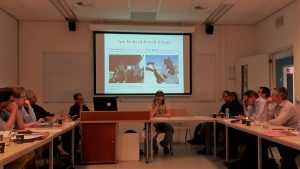
Professor Reno wrestled with the problems of presentism in the analysis of insurgencies. Using numerous African examples, but focusing in particular on South Sudan, he posed a crucial question: has the relationship between combatants and non-combatants changed in any meaningful way?
Taking Will Reno’s lead, among the topics discussed at the workshop, the merits of comparative approaches featured strongly, it being pointed out by numerous speakers that individual insurgency and counter-insurgency experiences within territories or empires were still too rarely collated with those of others.
KITLV researchers Bart Luttikhuis, Peter Keppy, Abdul Wahid in their joint paper, Violence strikes root: why political vigilantism became central to Indonesian politics, 1943-1957, opened proceedings with discussion of vigilantism, which they described as the phenomenon of non-state organisations pursuing their notions of justice through the extra-legal use of violence. Using late colonial Indonesia as their case-study, they questioned the widespread presumption that vigilnantism is intrinsically conservative or reactionary, noting that vigilantes are rarely seen as seeking a role in revolutionary violence or state formation. A key problem analysied was the matter of why vigilantism became a central element of post-colonial politics in Indonesia. Often characterised as the intersection of state and non-state, or criminal violence, the KITLV project suggests a more specific periodization, beginning with the Japanese occupation, which introduced militarised mass mobilisation, and was followed by the Indonesian Revolution whose leaders, unable to achieve an effective monopoly of violence, acknowledged and accommodated certain militias as recognised violence partners of the revolution.
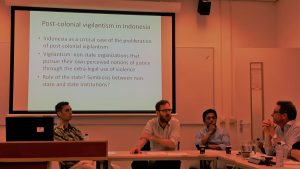
Clearly, as the research team acknowledged, the definitional boundaries between vigilantes, bandits, militias, paramilitaries, death squads, village watch groups, and so-called ‘people’s defence units’ are fluid, whether calibrated in terms of membership or analysed in terms of their operating principles. Such groups might be both conservative in their objectives and yet insurgent in their methods. Vigilantes, for instance, might aggregate the performative aspects of state punishment to their modes of violence. In other words, their cultural practices of violence may explain their perceived relationship to state authority.
Our Glasgow colleague Mathilde von Bülow pursued the discussion of insurgent motivation in her paper, ‘External sanctuaries and insurgent recruitment: the FLN in West Germany’
Mathilde’s paper highlighted the importance of sanctuary, of safe spaces, typically across an international frontier, to the operational survival of insurgent groups. As she pointed out, the idea of sanctuary has often been associated with religious safety, sacred ground, and respect for belief. But it may also be conceptualised as a discreet space for insurgent groups to survive and develop. Territorial sanctuaries function as force multipliers that limit the asymmetry of power between insurgent and counter-insurgent. Such sanctuaries have also been critical to the development of base areas and sometimes function as a basis for a proto-‘guerrilla state’.
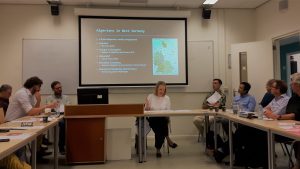
For Algeria’s Front de Libération Nationale (FLN), the primary sanctuaries used were across Algeria’s land frontiers, in Morocco and Tunisia. But another, European sanctuary also acquired increasing significance in the FLN’s rebellion against French colonial rule. That was West Germany, which became home to the FLN French Federation, based in Dusseldorf and masked as a social welfare provider to the roughly 8,000 Algerian immigrants in West Germany. The ensuing intelligence war between the French Federation and the French security services was perhaps the most striking feature of the internationalisation of the FLN’s war against France within the European Continent.
Dan Branch, one of our Warwick network colleagues, offered another perspective on the insurgent recruitment question with a fascinating survey of Loyalty and Rebellion in Imperial wars. As Dan noted, it is a commonplace in writings on empire and decolonisation to point out that colonial rule survived through systems of collaboration in which local auxiliaries performed numerous policing and security tasks. But, as he went on to discuss, much less has been written about the motives of the so-called loyalists involved in these bargains. Also overlooked has been the extent of administrative anxiety about the consequences of reliance on indigenous armed support. Colonial collaborators could be just as unsettling to imperial authorities as the more familiar anxieties about potential and actual rebels. Access to, and control of, firearms is a critical site at which criteria for loyalism are most sharply tested.
Dan’s paper analysed loyalism as a transactional process – a matter of bargaining concessions, rights, advantages, and material benefits in return for service, information, compliance, or coercive power. Often these transactions were related to the dispensation of land, wealth and power in the post-rebellion or post-colonial state, thereby ensuring consequences long beyond any ‘formal’ decolonisation.
Dan went on to describe the marked micro-variations in the reasons for such avowals of loyalism. But the trend analysis suggests a process that involved processes of reward and retrospective acknowledgement of performance of service. Rhetorical statements were rarely taken as sufficient indicator of loyalty and the easiest, often most readily applied definition was to be targeted by rebel violence, lethal or otherwise. So the very process of defining who was loyal and who was not was defined by the insurgents and, especially unsettling for the colonial state, not by the imperial power.
Leiden colleague Corinna Jentzsch’s shifted the geographical focus to Mozambique. Her paper, Sharpen your hoes and picks: Mobilization of pro-government militias during the civil war in Mozambique (1976-1992), examines the actions of lightly armed pro-Frelimo militias who were decisive in resisting the counter-revolutionary Renamo in Mozambique’s central provinces. Corinna noted that community-initiated militias were generally far more effective than state-orchestrated ones. Explanations advanced for this have usually discussed community-initiated militias through a classic collective action cost-benefit dynamic, measuring free riding against involvement in violence. This approach owes a good deal to rational choice theory.
But, as Corinna stressed, in the Mozambique militias’ case, recruitment tended to be predicated on appeals to pre-existing cultural practices and providing opportunities for self-empowerment. The key dynamic here was a powerful sense of vulnerability or insecurity rather than more logical calculations of risks for or against involvement in militia activities.
Gert Oostindie, another member of the network’s KITLV team at Leiden, discussed the KITLV’s major collaborative research project on Decolonization, Violence and War in Indonesia, 1945-50. Reminding us that the Dutch acknowledged their intention to leave within a year of their 1945 return to Indonesia and yet fought an acutely violent war before doing so, Gert provided several striking statistics: 220,000 Dutch troops deployed, some 5000 Dutch losses, and an estimated 100,000 Indonesian deaths.
He also pointed to a powerful tradition of Dutch exceptionalism. The first mention of Dutch war crimes in colonial Indonesia was made during a TV debate in 1969. Yet, it is far more recently, within the past five years or so, that the issue has entered public debate in the Netherlands once more. In 2011 Indonesian victims of the war pursued a series of successful prosecutions, which culminated in a Dutch Court condemning the Dutch rights abuses, ordering an apology and the payment of restitution to widows of Indonesians executed by the Dutch military. A new consensus seems to be emerging that the violence perpetrated during the last stages of Indonesia’s decolonisation was systemic and structural.
More information about these issues may be found at the project website
Keeping the focus on contested decolonisation in Southeast Asia, KITLV researcher and longstanding network associate Roel Frakking provided a comparative analysis in his paper, Alliance Formation in Indonesia and Malaya.
Roel highlighted the extensive mobilization of Indonesian youth groups – the Pemuda bands – within pro-independence militias. Although less numerous, there was also a pronounced mobilization of Chinese youth in support of the Malayan Communist insurgency in the early phrase of Malaya’s Emergency.
Roel suggested that the motivations for recruitment to insurgent or loyalist forces were often the result of lack of alternatives rather than a positive ideological choice. Short-term factors could be critical. Among the push factors involved were poverty and lack of opportunity; among the pull factors: coercion, violence opportunities, and fear of arrest.
If the motivational repertoires were varied and fluid, the result was what might be termed a contingent commitment. Roel stressed that recruitment to violent groups was not definitive but should be regarded as one moment among many at which contingent, temporary choices were made in the interests of survival, social advancement, retribution, or a host of other factors.
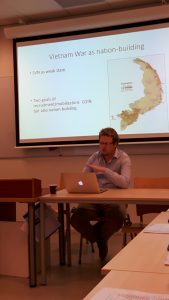
Andrew Gawthorpe of the University of Leiden shifted the focus to America’s involvement in Southeast Asia in his paper, Learning from the Enemy: loyalist militia and cadre recruitment in the Vietnam War. Andrew demonstrated that US efforts to recruit loyalist militias in South Vietnam were predicated on American attempts to understand and to replicate Vietnamese Communist practices as they were perceived by US strategic planners. Recruitment to loyalist militias were thus integrated into a wider process of nation building in South Vietnam.
The primary focus throughout was on rural communities whose loyalty and manpower capacity were judged critical by both sides.
Andrew illustrated his argument with discussion of the Office of Civil Operations and Revolutionary Development Support (CORDS), which was established in 1967 and represented as consolidation of the various agencies hitherto engaged in militia recruitment, including the State Department., the CIA, the US military, and USAID
Another KITLV colleague, Fridus Steijlen, returned us to Dutch Indonesia in his paper, Fighting on either side: Moluccans in the decolonization war.
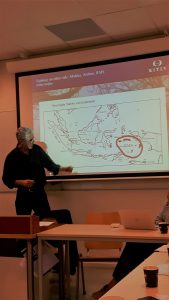
The Moluccans declared an independent RMS Moluccan republic in 1950, an action that provoked an Indonesian Republic invasion of the Moluccan islands in July 1950. As Fridus pointed out, Moluccans, following their involvement in the Aceh war, were studied by colonial historians interested in the fact that the Moluccans, as a supposedly warlike community, drew classic ascriptions of martial race discourse. In fact, their recruitment to the Dutch colonial security forces, the KNIL, was more a matter of assured economic security. Furthermore, numerous Dutch colonial administrators, keen advocates of martial race theory, introduced recruitment quotas in Moluccan villages for which responsibility was assigned to village heads. Signficantly, during the Japanese occupation of 1942-45, captured Moluccan troops were retained as POWs whereas Javanese troops were disarmed and sent home. Whether a colonial cultural construction or not, the Moluccans’ martial reputation was shared by Indonesian Republican authorities, who also sought out Moluccan recruits. As Fridus concluded, this situation left Moluccan communities doubly exposed.
Another distinct community to suffer disproportionately during Indonesia’s decolonisation was the Chinese diaspora, the subject of Anne van der Veer’s fascinating paper, Forgotten Allies: Chinese fighters in revolutionary and counter-revolutionary East Sumatra, 1945-50
As Anne reminded us, in some parts of Indonesia, the Chinese diaspora community was very large. In certain towns of East Sumatra, for instance, the Chinese population ran to between 20 to 40 per cent of the urban population while, across the region as a whole, the Chinese constituted some ten per cent as a whole.
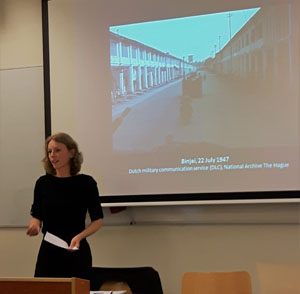
Targeted during the initial phases of the fighting in 1945-6, Chinese community groups quickly established a Chinese Security Corps, their primary loyalty being to China’s Nationalist Guomindang. The Security Corps’ principal role was to protect Chinese communities, providing relief to those districts that had suffered losses and property destruction. Anne’s paper explored the resultant combination of combination of loyalism, diasporic nationalism and community defence. What she identified as a ‘diasporic vigilantism’ based on a combination of these transnational loyalties soon emerged.
Chinese guard brigades, for instance, adopted the idiom of Indonesian youth brigades (pemudas) but adapted it to their ethnic self-defence. Most considered their de facto cooperation with the Dutch security forces a ‘necessary evil’.
As these brief summaries indicate, the Leiden conference revealed the richness of the research currently being conducted into comparative study of insurgencies. We will be returning to these themes, as well as exploring others, in our forthcoming workshops in Montreal, Glasgow and Lisbon.
Comments are closed, but trackbacks and pingbacks are open.